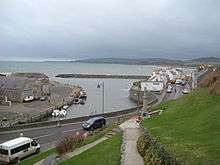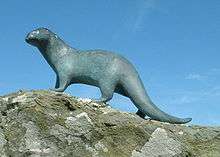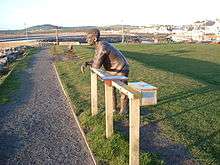Port William, Dumfries and Galloway



Port William is a fishing village in the parish of Mochrum, Wigtownshire, Dumfries and Galloway, in south-west Scotland with a population of approximately 460. It is surrounded by the hamlets of Elrig, Mochrum and Monreith. [1]. Port William lies 23 miles east of the town of Stranraer, on the coast of Luce Bay. It looks towards the Mull of Galloway (the most southerly point of the Scottish mainland) and, on a clear day, the Isle of Man and Ireland are visible.
The original settlement was known as Killantrae, meaning 'The Church on the Beach' in Gaelic, and was probably founded not long after St Ninian arrival in nearby Whithorn towards the end of the 4th century. [2]
Killantrae was swept away following the intervention of developer and landlord Sir William Maxwell, 5th Baronet, of Monreith House. [3] In the five years until 1776 he built an entirely new village, complete with a good harbour and renamed it Port William. One of the earliest buildings still standing was the corn mill, located on the side of the Killantrae burn to take advantage of the power provided by its water. Port William is an example of a planned village, lying on the eastern shore of Luce Bay in Galloway. The harbour, built for the convenience of his tenant farmers, was one of the first in western Galloway.
In the 17th and 18th centuries Port William was known as much for the illicit activities of its smugglers as for the legitimate trade of its port.
Following the withdrawal of the RNLI lifeboat in the early 1980s, Port William raised funds to buy and staff an Inshore Rescue Boat, which still operates today, covering Luce Bay, Wigtown Bay and the inshore waters between SW Scotland and the Isle of Man. The village formed one of the first Community First Response Teams in Scotland and has helped to set up other teams in the area.
Monreith House, a category A listed Georgian mansion is located 1.5 kilometres (0.93 mi) east of the village.[4]
The Harbour
The harbour was extended in 1790 and again in 1848; its commercial importance continuing until the end of the First World War.
Further work was done to protect the harbour in the 1980s by building a breakwater to the western side of the harbour.
A statue of a fisherman overlooks the harbour: once made of concrete, it has been cast in bronze. The statue was part-funded by the millennium lottery fund. In front of the statue is a plaque with the first verse of the poem Leisure by W. H. Davies.
References
- ↑ "Port William Feature Page on Undiscovered Scotland". Undiscoveredscotland.co.uk. Retrieved 2014-06-18.
- ↑ "History". PortWilliam. Retrieved 2014-06-18.
- ↑ Sir William Maxwell, 4th Baronet
- ↑ "Monreith House: listed building report". Historic Scotland. Retrieved 2011-03-16.
| Wikimedia Commons has media related to Port William, Dumfries and Galloway. |